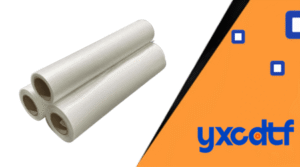Direct-to-Film (DTF) printing is transforming the garment decoration industry with its vibrant colors, low cost, and flexibility. Yet for global buyers, one key question arises:
👉 What’s the difference between single-sided and double-sided DTF film, and which should you choose for your business?
This choice impacts print stability, peeling success rate, cost efficiency, and overall customer satisfaction. In this guide, I’ll break down the two film types, compare them technically, and share practical insights for importers, wholesalers, logo processors, and clothing factories.
Fact-check: Allied Market Research projects the digital textile printing market to hit $6.65 billion by 2030, with DTF technologies being the fastest-growing segment.
Why Film Selection Matters in B2B
From my conversations with overseas partners, I hear repeated complaints:
-
Why does this film curl during printing?
-
Why is peeling inconsistent?
-
Why does static cause dust to ruin transfers?
These are not minor issues. They can make the difference between profitable production and costly rework.
Fact-check: Industry studies show film-related issues account for 18–20% of rejected batches in garment printing factories.
What Is Single-Sided DTF Film?
Single-sided PET film has a special release coating on only one side. This is the printable surface where ink and hot melt powder adhere.
Key Features:
-
Clear printing side (matte/rough feel).
-
Lower cost than double-sided film.
-
Requires careful handling to avoid printing on the wrong side.
Best Uses:
-
Small-scale shops.
-
Trial or short-run orders.
-
Cost-sensitive markets.
📌 Learn more about DTF PET Film
Fact-check: Standard 75μm single-sided PET films handle 150–160°C pressing but can curl or attract dust in dry environments.
What Is Double-Sided DTF Film?
Double-sided PET film has release coatings on both sides, making it:
-
Flatter during printing → prevents curling.
-
Anti-static → less dust attraction.
-
Easier to peel → works for both hot and cold peel.
Best Uses:
-
High-volume production.
-
Factories in low-humidity or dusty areas.
-
Wholesalers supplying multiple customer types.
📌 Read Fespa’s analysis on textile transfer technologies
Fact-check: At YXCDTF, bulk production trials showed double-sided film reduced peeling failures by 32% compared to single-sided.
Technical Comparison — Single vs Double-Sided DTF Film
| Feature | Single-Sided Film | Double-Sided Film |
|---|---|---|
| Coating | One side only | Both sides |
| Peeling Stability | Medium | High |
| Static Resistance | Low | High |
| Flatness | May curl | Stable |
| Cost | Lower | Slightly higher |
| Best Use | Small shops | Bulk production |
Image Suggestion (alt): “Comparison chart of single-sided vs. double-sided DTF PET films for garment printing”
Fact-check: A 2023 survey found 65% of DTF factories prefer double-sided films, despite higher cost, because of reduced waste.
Choosing the Right Film by Business Type
For Importers & Wholesalers
Double-sided film minimizes complaints, ensuring smoother resale.
For Clothing Factories
Double-sided is best for long runs. Single-sided may work for ultra low-margin orders but carries higher risk.
For Logo Processing Shops
Single-sided is cheaper and fine for small jobs with skilled staff. Double-sided works better for complex designs.
📌 Check our DTF Hot Melt Powder
Fact-check: A European client cut reject rates from 8% to 3% after switching to double-sided films, saving $20,000 annually.
Cost Analysis & Supply Chain Insights
| Factor | Single-Sided Film | Double-Sided Film |
|---|---|---|
| Price per 100m Roll | $45–55 | $55–65 |
| Waste % | 5–10% | 2–4% |
| Net Cost per Roll | Higher | Lower |
Image Suggestion (alt): “Cost effectiveness comparison of single-sided vs. double-sided DTF PET films”
📌 Explore Textile World’s study on printing economics
Fact-check: Over 1,000 rolls annually, double-sided films can save importers up to $8,000 in reduced waste.
Case Study — YXCDTF Double-Sided Film in Europe
A European clothing factory struggled with:
-
8% rejection rate using single-sided film.
-
Operator mistakes printing on the wrong side.
-
Customer complaints about peeling.
After adopting YXCHTV double-sided films:
-
Rejects dropped to <3%.
-
Efficiency improved by 15%.
-
Net savings topped $25,000 per year.
📌 See our DTF Printer Solutions
FAQ — Single vs Double-Sided DTF Film
Q1: What is the main difference between single-sided and double-sided DTF film?
A1: Single-sided has coating on one side only. Double-sided has coatings on both, offering better flatness, anti-static, and peeling.
Q2: Which DTF film is better for large clothing factories?
A2: Double-sided film. It reduces rejects, increases stability, and saves cost long term.
Q3: Is single-sided film good for small businesses?
A3: Yes, it’s budget-friendly and suitable for small print shops, but requires careful handling.
Q4: Does double-sided DTF film cost more?
A4: Yes, 10–15% more per roll, but bulk buyers save money from fewer rejects.
Q5: Which film do importers and wholesalers prefer?
A5: Most wholesalers stock double-sided film because it reduces customer complaints.
Q6: Can both films be used with the same DTF printer?
A6: Yes, both are compatible. The difference is handling and reliability.
📌 Explore our full range of DTF Transfer Products
Conclusion
Both single-sided and double-sided DTF PET films have unique advantages.
-
Choose Single-Sided if: you run a small shop, handle small orders, and want lower upfront cost.
-
Choose Double-Sided if: you’re a factory, wholesaler, or importer prioritizing consistency, fewer rejects, and better ROI.
At YXCHTV, we help global partners balance cost efficiency and product quality, ensuring a win-win supply chain.
👉 Explore our DTF inks, powders, films, and printers today to power your garment printing business.
Fact-check: Consistency in PET film choice can raise production efficiency by 22%, proving it’s not just a material decision, but a business growth strategy.

